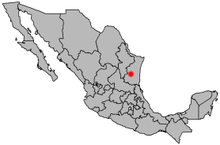
Dudleya, commonly known as liveforevers is a genus of rosette-forming succulent plants in the stonecrop family, Crassulaceae, consisting of about 68 taxa in southwestern North America and Guadalupe Island. The species come in many forms, some large and evergreen, others geophytic and deciduous. Yet, despite their dramatic variations in appearance, most species readily hybridize. The flowers of Dudleya have parts numbered in fives, with the petals arranged in tubular, star-shaped, and bell-shaped forms and, when fruiting, are filled with tiny, ovoid-crescent-shaped seeds.

Pinguicula moranensis is a perennial rosette-forming insectivorous herb in the flowering plant family Lentibulariaceae. It is native to El Salvador, Guatemala, Honduras and Mexico. A species of butterwort, it forms summer rosettes of flat, succulent leaves up to 10 centimeters (4 in) long, which are covered in mucilaginous (sticky) glands that attract, trap, and digest arthropod prey. Nutrients derived from the prey are used to supplement the nutrient-poor substrate that the plant grows in. In the winter the plant forms a non-carnivorous rosette of small, fleshy leaves that conserves energy while food and moisture supplies are low. Single pink, purple, or violet flowers appear twice a year on upright stalks up to 25 centimeters long.
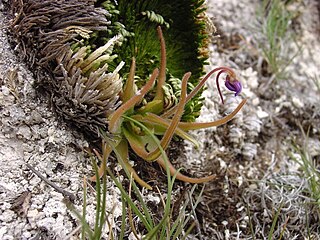
Pinguicula gypsicola is an insectivorous plant of the genus Pinguicula native to the Mexican state of San Luis Potosi, a heterophyllous member of the section Orcheosanthus. It grows in gypsum soils and forms stemless rosettes of upright, narrow leaves.

Pinguicula ramosa is a species of butterwort, a carnivorous plant, endemic to the mountains of Nikkō National Park in Japan. It belongs to the section micranthus and is closely related to Pinguicula variegata. It is unique in the genus for having a forked flower stalk.

Pinguicula conzattii is an insectivorous plant of the genus Pinguicula native to the Mexican state of Oaxaca, a member of the section Heterophyllum. Closely related to Pinguicula mirandae, it is notable for being pubescent on both sides of its winter leaves. It is named in honour of Cassiano Conzatti, an Italian-born botanist who spent most of his life in Mexico.

Pinguicula acuminata is an insectivorous plant of the genus Pinguicula endemic to the Mexican state of Hidalgo, a member of the section Heterophyllum. It is notable for producing flowers while the winter rosette is buried beneath the soil surface. Described in 1839, it was not rediscovered until 150 years later.

Ariocarpus agavoides is a species of cactus. It is endemic to Mexico. It grows in dry shrubland in rocky calcareous substrates. Some taxonomists place it in a separate genus as Neogomezia agavoides. The locals use the slime from the roots of the plants as glue to repair pottery. The sweet-tasting warts are eaten and often added to salads

Agave is a genus of monocots native to the hot and arid regions of the Americas and the Caribbean, although some Agave species are also native to tropical areas of North America, such as Mexico. The genus is primarily known for its succulent and xerophytic species that typically form large rosettes of strong, fleshy leaves. Agave now includes species formerly placed in a number of other genera, such as Manfreda, ×Mangave, Polianthes and Prochnyanthes.
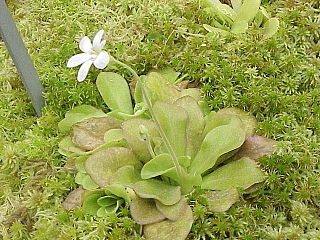
Pinguicula agnata is a tropical species of carnivorous plant in the family Lentibulariaceae. Its flowers are a blue-violet color. Pinguicula agnata is native to northeastern Mexico. Its sticky leaves are lined with stiff bristles which capture unsuspecting prey upon contact, its large white to purple flowers bloom late in the spring, and its succulent leaves retain moisture during the dry season. Endemic to humid pine forests, this remarkable plant has adapted perfectly to take advantage of the ideal environment it needs for survival.

Pinguicula orchidioides is a perennial rosette-forming insectivorous herb native to Mexico and Guatemala. A species of butterwort, it forms summer rosettes of flat, succulent leaves up to 5 centimeters (2 in) long, which are covered in mucilaginous (sticky) glands that attract, trap, and digest arthropod prey. Nutrients derived from the prey are used to supplement the nutrient-poor substrate that the plant grows in. Uniquely among Pinguicula species from the Americas, p. orchidioides produces gemma-like basal buds which elongate into stolons and serve as a means of asexual reproduction. In the winter the plant forms a non-carnivorous rosette of small, fleshy leaves that conserves energy while food and moisture supplies are low. Single purple flowers appear between July and September on upright stalks up to 22 centimeters long.
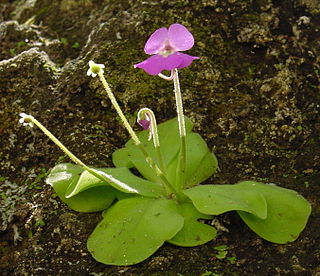
Pinguicula elizabethiae is a perennial rosette-forming insectivorous herb native to the Mexican states of Querétaro and Hidalgo. A species of butterwort, it forms summer rosettes of flat, succulent leaves up to 5 centimeters (4 in) long, which are covered in mucilaginous (sticky) glands that attract, trap, and digest arthropod prey. Nutrients derived from the prey are used to supplement the nutrient-poor substrate that the plant grows in. In the winter the plant forms a non-carnivorous rosette of small, fleshy leaves that conserves energy while food and moisture supplies are low. Single purple flowers appear between July and October on upright stalks up to 75 millimeters long.
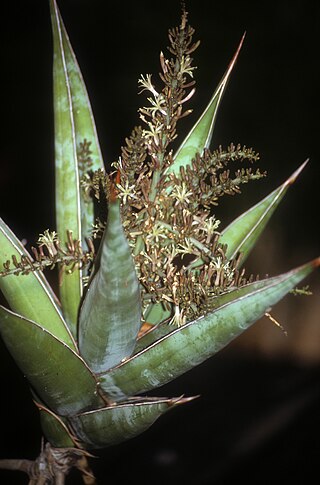
Dracaena pinguicula, synonym Sansevieria pinguicula, also known as the walking sansevieria, is a xerophytic CAM succulent native to the Bura area of Kenya, near Garissa. The species was described by Peter René Oscar Bally in 1943.

Pinguicula, commonly known as butterworts, is a genus of carnivorous flowering plants in the family Lentibulariaceae. They use sticky, glandular leaves to lure, trap, and digest insects in order to supplement the poor mineral nutrition they obtain from the environment. Of the roughly 80 currently known species, 13 are native to Europe, 9 to North America, and some to northern Asia. The largest number of species is in South and Central America.

Pinguicula ionantha is a rare species of flowering plant in the butterwort family known by the common names Godfrey's butterwort and violet butterwort. It is endemic to the US state of Florida, where it only occurs in the central Florida Panhandle. It is threatened by the loss of its habitat, and it is a federally listed threatened species of the United States.

One of only two species in its genus, Calibanus hookeri is a member of the family Asparagaceae native to Tamaulipas in Mexico, which can easily be mistaken in the wild for a boulder overgrown with grass tufts.

Dudleya ingens is a species of perennial succulent plant in the family Crassulaceae commonly known as the rock liveforever or Baja liveforever. A relatively large member of the genus Dudleya, this species has long green succulent leaves, and in April to June is characterized by pale yellow to white pink-tinged flowers topping tall, reddish inflorescences. It has a stem clothed densely with old, leathery leaves, and the inflorescence may be nodding, with the floral branches bearing the flowers tending to unfurl like the fronds of a fern. It is similar in appearance to Dudleya brittonii, but differs in range and chromosome number. This species is endemic to the state of Baja California in Mexico, being found from Santo Tomás to the southern coast of the state.

Pinguicula pumila, commonly known as the small butterwort or dwarf butterwort is a small species of carnivorous plant in the genus Pinguicula. It is native to the southeastern United States, where it grows in habitats where soil is poor in nutrition.

Pinguicula cyclosecta is a perennial rosette-forming insectivorous plant native to the state of Nuevo León in Mexico.
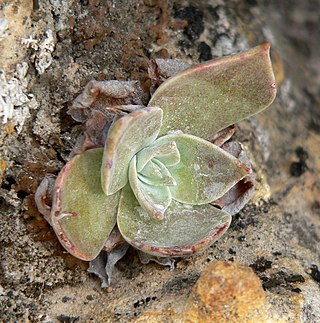
Dudleya arizonica is a species of perennial succulent plant commonly known as the Arizona chalk dudleya and the Arizona liveforever. A member of the genus Dudleya, this species is characterized by long, red flowers that adorn a waxy rosette of succulent leaves. It resembles a reduced desert form of the more coastal chalk dudleya, Dudleya pulverulenta, but differs in its smaller stature, lower number of leaves, and orientation of the flowers. Native to the southwestern United States and northwestern Mexico, it is widespread in range, but is primarily found in scattered, widely separated localities. It can be found as far west as coastal Ensenada to the desolate desert ranges of Nevada. It is one of two species of Dudleya that occur in Arizona, the other being Dudleya saxosa subsp. collomiae, and is the only species on mainland Mexico and in Utah.

